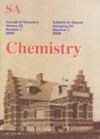用GC/MS分析红圆菌的脂质组学特征,用DPPH和TLC-Plate测定其抗氧化能力
IF 1
4区 化学
Q4 CHEMISTRY, MULTIDISCIPLINARY
South African Journal of Chemistry-Suid-Afrikaanse Tydskrif Vir Chemie
Pub Date : 2021-01-01
DOI:10.17159/0379-4350/2021/v75a20
引用次数: 1
摘要
本研究采用(DPPH)(1,1-二苯基-2-吡咯-肼)方法,以TLC板评价红torula toruloides脂质提取物的抗氧化能力,该方法是一种创新的方法,可以可视化包含该活性的脂质基团。同样,用DPPH和β-胡萝卜素/亚油酸法分析了类胡萝卜素和原油的抗氧化能力。脂质组学分析采用GC/MS和HPLC/DAD方法。采用超声辅助酯交换法制备样品进行气相色谱/质谱分析。游离化合物用BSTFA (N,O-Bis(三甲基硅基)三氟乙酰胺)+ 1% TMCS(三甲基氯硅烷)进行硅基化。脂质提取物分析表明,皂化部分中存在饱和脂肪酸(SFA)和单不饱和脂肪酸(MUFA);在不能皂化的部分中含有类固醇和类胡萝卜素。抗氧化能力表示为IC50达到6.4 mg/L,即相对效率。利用薄层色谱法,油的剖面显示了化学基团:类胡萝卜素、酰基甘油、游离脂肪酸和类固醇。同样,GC/ MS分析显示脂肪酸和类固醇。HPLC分析描述了类胡萝卜素的特征,突出了b-胡萝卜素占多数,并存在ß-胡萝卜素-5,8-环氧化物,玉米黄质和b-隐黄质,表征了该酵母的脂质组学研究。关键词:DPPH-TLC,脂质代谢物类别,tlc -抗氧化系统。本文章由计算机程序翻译,如有差异,请以英文原文为准。
Lipidomic Profile of Rhodotorula toruloides by GC/MS and Antioxidant Capacity of the Oil by DPPH and TLC-Plate Methods
ABSTRACT This work was undertaken to evaluate the antioxidant capacity of Rhodotorula toruloides lipid extract in TLC plate, using the (DPPH) (1,1-diphenyl-2-picril-hydrazine) method as an innovative way to visualise lipid groups that comprise this activity. Similarly, carotenoids and crude oil were analysed for antioxidant capacity by the DPPH and β-carotene/linoleic acid methods. The lipidomic profile extract analysis was performed by GC/MS and HPLC/DAD. The sample preparation for the GC/MS analysis was made by ultrasound-assisted transesterification. Free compounds were silylated with BSTFA (N,O-Bis (trimethylsilyl) trifluoracetamide) + 1% TMCS (Trimethylchlorosilane). The analysis of the lipid extract showed that in the saponifiable fraction saturated fatty acids (SFA) and monounsaturated fatty acids (MUFA) were present; and in the unsaponifiable fraction were steroids and carotenoids. The antioxidant capacity was expressed as IC50 reaching 6.4 mg/L that means relative efficiency. The oil profile, using TLC, shows the chemical groups: carotenoids, acylglycerols, free fatty acids and steroids. Similarly, the GC/ MS analysis shows the fatty acids and steroids. The HPLC analysis describes the carotenoids profile, highlighting b-carotene as the majority and the presence of ß-carotene-5,8-epoxide, zeaxanthin and b-cryptoxanthin, characterising the lipidomic study of this yeast. Keywords: DPPH-TLC, lipid metabolite classes, TLC-antioxidant system.
求助全文
通过发布文献求助,成功后即可免费获取论文全文。
去求助
来源期刊
CiteScore
3.10
自引率
0.00%
发文量
6
审稿时长
>12 weeks
期刊介绍:
Original work in all branches of chemistry is published in the South African Journal of Chemistry. Contributions in English may take the form of papers, short communications, or critical reviews.

 求助内容:
求助内容: 应助结果提醒方式:
应助结果提醒方式:


